Optimizing Backfill Materials for Ground Heat Exchangers: A Study on Recycled Concrete Aggregate and Fly Ash for Enhanced Thermal Conductivity
Abstract
1. Introduction
2. Materials and Methods
2.1. Material
2.2. Thermal Conductivity Measurement
2.2.1. Sample Preparation and Compaction
2.2.2. Sensor Installation and Thermal Conductivity Measurement
2.2.3. Post-Test Physical Properties’ Measurement
3. Results
3.1. Thermal Conductivity Test Results
3.2. Thermal Conductivity Modeling
4. Discussion
5. Conclusions
Funding
Data Availability Statement
Conflicts of Interest
References
- Shah, A.; Krarti, M.; Huang, J. Energy Performance Evaluation of Shallow Ground Source Heat Pumps for Residential Buildings. Energies 2022, 15, 1025. [Google Scholar] [CrossRef]
- Lucia, U.; Simonetti, M.; Chiesa, G.; Grisolia, G. Ground-Source Pump System for Heating and Cooling: Review and Thermodynamic Approach. Renew. Sustain. Energy Rev. 2017, 70, 867–874. [Google Scholar] [CrossRef]
- Liu, X.; Spitler, J.D.; Qu, M.; Shi, L. Recent Developments in the Design of Vertical Borehole Ground Heat Exchangers for Cost Reduction and Thermal Energy Storage. J. Energy Resour. Technol. 2021, 143, 100803. [Google Scholar] [CrossRef]
- Gao, J.; Li, A.; Xu, X.; Gang, W.; Yan, T. Ground Heat Exchangers: Applications, Technology Integration and Potentials for Zero Energy Buildings. Renew. Energy 2018, 128, 337–349. [Google Scholar] [CrossRef]
- Di Sipio, E.; Bertermann, D. Influence of Different Moisture and Load Conditions on Heat Transfer Within Soils in Very Shallow Geothermal Application: An Overview of ITER Project; Stanford University: Stanford, CA, USA, 2017; pp. 1345–1353. [Google Scholar]
- Costa, S.; Cherukuvada, M.; Islam, T.; Kodikara, J. Impact of Climate Change on Shallow Ground Hydro-Thermal Properties. Bull. Eng. Geol. Environ. 2023, 82, 16. [Google Scholar] [CrossRef]
- Chalhoub, M.; Bernier, M.; Coquet, Y.; Philippe, M. A Simple Heat and Moisture Transfer Model to Predict Ground Temperature for Shallow Ground Heat Exchangers. Renew. Energy 2017, 103, 295–307. [Google Scholar] [CrossRef]
- Wang, H.; Cui, Y.; Qi, C. Effects of Sand–Bentonite Backfill Materials on the Thermal Performance of Borehole Heat Exchangers. Heat Transf. Eng. 2013, 34, 37–44. [Google Scholar] [CrossRef]
- Chehab, A.G.; Moore, I.D. Parametric Study Examining the Short and Long Term Response of HDPE Pipes When Installed by Horizontal Directional Drilling. Tunn. Undergr. Space Technol. 2010, 25, 782–794. [Google Scholar] [CrossRef]
- Blázquez, C.S.; Martín, A.F.; Nieto, I.M.; García, P.C.; Sánchez Pérez, L.S.; González-Aguilera, D. Analysis and Study of Different Grouting Materials in Vertical Geothermal Closed-Loop Systems. Renew. Energy 2017, 114, 1189–1200. [Google Scholar] [CrossRef]
- Kim, D.; Kim, G.; Baek, H. Relationship between Thermal Conductivity and Soil–Water Characteristic Curve of Pure Bentonite-Based Grout. Int. J. Heat Mass Transf. 2015, 84, 1049–1055. [Google Scholar] [CrossRef]
- Gonzalez, R.G.; Verhoef, A.; Vidale, P.L.; Main, B.; Gan, G.; Wu, Y. Interactions between the Physical Soil Environment and a Horizontal Ground Coupled Heat Pump, for a Domestic Site in the UK. Renew. Energy 2012, 44, 141–153. [Google Scholar] [CrossRef]
- Lu, S.; Ren, T.; Gong, Y.; Horton, R. An Improved Model for Predicting Soil Thermal Conductivity from Water Content at Room Temperature. Soil Sci. Soc. Am. J. 2007, 71, 8–14. [Google Scholar] [CrossRef]
- Horai, K. Thermal Conductivity of Rock-Forming Minerals. J. Geophys. Res. 1971, 76, 1278–1308. [Google Scholar] [CrossRef]
- Midttømme, K.; Roaldset, E.; Aagaard, P. Thermal Conductivity of Selected Claystones and Mudstones from England. Clay Min. 1998, 33, 131–145. [Google Scholar] [CrossRef]
- Li, S.; Huang, M.; Cui, M.; Jiang, Q.; Xu, K. Thermal Conductivity Enhancement of Backfill Material and Soil Using Enzyme-Induced Carbonate Precipitation (EICP). Acta Geotech. 2023, 18, 6143–6158. [Google Scholar] [CrossRef]
- Zakarka, M.; Skuodis, Š.; Šiupšinskas, G.; Bielskus, J. Compressive Strength and Thermal Properties of Sand–Bentonite Mixture. Open Geosci. 2021, 13, 988–998. [Google Scholar] [CrossRef]
- Song, X.; Zheng, R.; Li, R.; Li, G.; Sun, B.; Shi, Y.; Wang, G.; Zhou, S. Study on Thermal Conductivity of Cement with Thermal Conductive Materials in Geothermal Well. Geothermics 2019, 81, 1–11. [Google Scholar] [CrossRef]
- Balaji, N.C.; Mani, M.; Venkatarama Reddy, B.V. Thermal Conductivity Studies on Cement-Stabilised Soil Blocks. Proc. Inst. Civ. Eng. Constr. Mater. 2017, 170, 40–54. [Google Scholar] [CrossRef]
- Principles of Soil and Plant Water Relations; Elsevier: Amsterdan, The Netherlands, 2014; ISBN 978-0-12-420022-7.
- Rozanski, A. On the Prediction of the Thermal Conductivity of Saturated Clayey Soils: Effect of the Specific Surface Area. Acta Geodyn. Geomater. 2016, 339–349. [Google Scholar] [CrossRef]
- Łydżba, D.; Różański, A.; Rajczakowska, M.; Stefaniuk, D. Efficiency of the Needle Probe Test for Evaluation of Thermal Conductivity of Composite Materials: Two-Scale Analysis. Stud. Geotech. Mech. 2014, 36, 55–62. [Google Scholar] [CrossRef]
- Sas, W.; Dzięcioł, J.; Radzevičius, A.; Radziemska, M.; Dapkienė, M.; Šadzevičius, R.; Skominas, R.; Głuchowski, A. Geotechnical and Environmental Assessment of Blast Furnace Slag for Engineering Applications. Materials 2021, 14, 6029. [Google Scholar] [CrossRef] [PubMed]
- Głuchowski, A.; Šadzevičius, R.; Skominas, R.; Sas, W. Compacted Anthropogenic Materials as Backfill for Buried Pipes. Materials 2021, 14, 717. [Google Scholar] [CrossRef] [PubMed]
- Bhatt, A.; Priyadarshini, S.; Acharath Mohanakrishnan, A.; Abri, A.; Sattler, M.; Techapaphawit, S. Physical, Chemical, and Geotechnical Properties of Coal Fly Ash: A Global Review. Case Stud. Constr. Mater. 2019, 11, e00263. [Google Scholar] [CrossRef]
- Belviso, C. State-of-the-Art Applications of Fly Ash from Coal and Biomass: A Focus on Zeolite Synthesis Processes and Issues. Prog. Energy Combust. Sci. 2018, 65, 109–135. [Google Scholar] [CrossRef]
- Vassilev, S.V.; Vassileva, C.G. A New Approach for the Classification of Coal Fly Ashes Based on Their Origin, Composition, Properties, and Behaviour. Fuel 2007, 86, 1490–1512. [Google Scholar] [CrossRef]
- Akbulut, Z.F.; Yavuz, D.; Tawfik, T.A.; Smarzewski, P.; Guler, S. Enhancing Concrete Performance through Sustainable Utilization of Class-C and Class-F Fly Ash: A Comprehensive Review. Sustainability 2024, 16, 4905. [Google Scholar] [CrossRef]
- He, H.; Zhang, C.; Yang, J.; Li, M.; Fu, W.; Senetakis, K.; Zhang, D.; Liu, S. Characterization of Recycled Concrete Aggregate (RCA) Particles for Geotechnical Engineering Applications: Particle Strength and Interparticle Contact Behavior. Constr. Build. Mater. 2023, 407, 133532. [Google Scholar] [CrossRef]
- Gabryś, K.; Soból, E.; Sas, W. Physical, Deformation, and Stiffness Properties of Recycled Concrete Aggregate. Sustainability 2021, 13, 4245. [Google Scholar] [CrossRef]
- Sas, W.; Głuchowski, A.; Gabryś, K.; Soból, E.; Szymański, A. Deformation Behavior of Recycled Concrete Aggregate during Cyclic and Dynamic Loading Laboratory Tests. Materials 2016, 9, 780. [Google Scholar] [CrossRef]
- He, H.; Senetakis, K. A Study of Wave Velocities and Poisson Ratio of Recycled Concrete Aggregate. Soils Found. 2016, 56, 593–607. [Google Scholar] [CrossRef]
- Sharma, A.; Shrivastava, N.; Lohar, J. Assessment of Geotechnical and Geo-Environmental Behaviour of Recycled Concrete Aggregates, Recycled Brick Aggregates and Their Blends. Clean. Mater. 2023, 7, 100171. [Google Scholar] [CrossRef]
- Arulrajah, A.; Piratheepan, J.; Disfani, M.M.; Bo, M.W. Resilient Moduli Response of Recycled Construction and Demolition Materials in Pavement Subbase Applications. J. Mater. Civ. Eng. 2013, 25, 1920–1928. [Google Scholar] [CrossRef]
- Hukseflux Thermal Sensors TP08 Small Size Non-Steady-State Probe for Thermal Conductivity Measurement 2012. Available online: https://www.hukseflux.com/uploads/product-documents/TP08_manual_v2012.pdf (accessed on 26 November 2024).
- Woodside, W.; Messmer, J.H. Thermal Conductivity of Porous Media. I. Unconsolidated Sands. J. Appl. Phys. 1961, 32, 1688–1699. [Google Scholar] [CrossRef]
- Xiong, K.; Feng, Y.; Jin, H.; Liang, S.; Yu, K.; Kuang, X.; Wan, L. A New Model to Predict Soil Thermal Conductivity. Sci. Rep. 2023, 13, 10684. [Google Scholar] [CrossRef]
- He, H.; Zhao, Y.; Dyck, M.F.; Si, B.; Jin, H.; Lv, J.; Wang, J. A Modified Normalized Model for Predicting Effective Soil Thermal Conductivity. Acta Geotech. 2017, 12, 1281–1300. [Google Scholar] [CrossRef]
- Thai, H.N.; Kawamoto, K.; Nguyen, H.G.; Sakaki, T.; Komatsu, T.; Moldrup, P. Measurements and Modeling of Thermal Conductivity of Recycled Aggregates from Concrete, Clay Brick, and Their Mixtures with Autoclaved Aerated Concrete Grains. Sustainability 2022, 14, 2417. [Google Scholar] [CrossRef]
- Yasipourtehrani, S.; Strezov, V.; Bliznyukov, S.; Evans, T. Investigation of Thermal Properties of Blast Furnace Slag to Improve Process Energy Efficiency. J. Clean. Prod. 2017, 149, 137–145. [Google Scholar] [CrossRef]
- Choo, H.; Won, J.; Burns, S.E. Thermal Conductivity of Dry Fly Ashes with Various Carbon and Biomass Contents. Waste Manag. 2021, 135, 122–129. [Google Scholar] [CrossRef]
- Kanti, P.; Korada, V.S.; Ramachandra, C.G.; Sesha Talpa Sai, P.H.V. Experimental Study on Density and Thermal Conductivity Properties of Indian Coal Fly Ash Water-Based Nanofluid. Int. J. Ambient. Energy 2022, 43, 2557–2562. [Google Scholar] [CrossRef]
- Cui, S.; Zhou, C.; Zhang, J. Experimental Investigations on the State-Dependent Thermal Conductivity of Sand-Rubber Mixtures. J. Mater. Civ. Eng. 2022, 34, 04021492. [Google Scholar] [CrossRef]
- Karaki, A.; Mohammad, M.; Masad, E.; Khraisheh, M. Theoretical and Computational Modeling of Thermal Properties of Lightweight Concrete. Case Stud. Therm. Eng. 2021, 28, 101683. [Google Scholar] [CrossRef]
- Zhuo, Z.; Zhu, C.; Ali, A.; Mehta, Y.; Lein, W.; DeCarlo, C.; Elshaer, M.; Hewage, S.D.A.; Cai, W. Comparative Study of Different Materials for Insulated Pavement in Cold Regions. Cold Reg. Sci. Technol. 2023, 210, 103851. [Google Scholar] [CrossRef]
- Orozco, C.; Tangtermsirikul, S.; Sugiyama, T.; Babel, S. Examining the Endpoint Impacts, Challenges, and Opportunities of Fly Ash Utilization for Sustainable Concrete Construction. Sci. Rep. 2023, 13, 18254. [Google Scholar] [CrossRef] [PubMed]
- Głuchowski, A.; Sas, W.; Dzięcioł, J.; Soból, E.; Szymański, A. Permeability and Leaching Properties of Recycled Concrete Aggregate as an Emerging Material in Civil Engineering. Appl. Sci. 2018, 9, 81. [Google Scholar] [CrossRef]
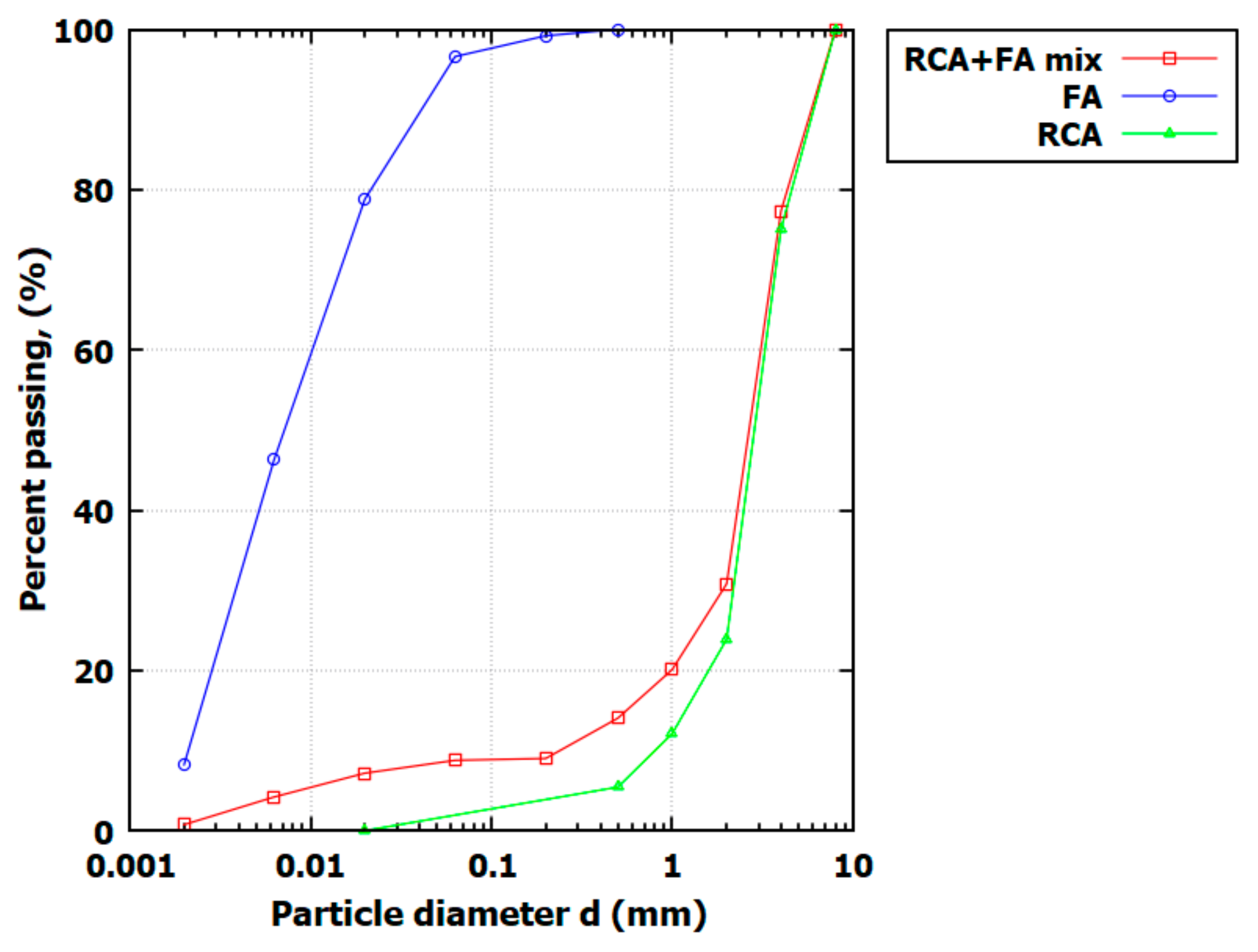
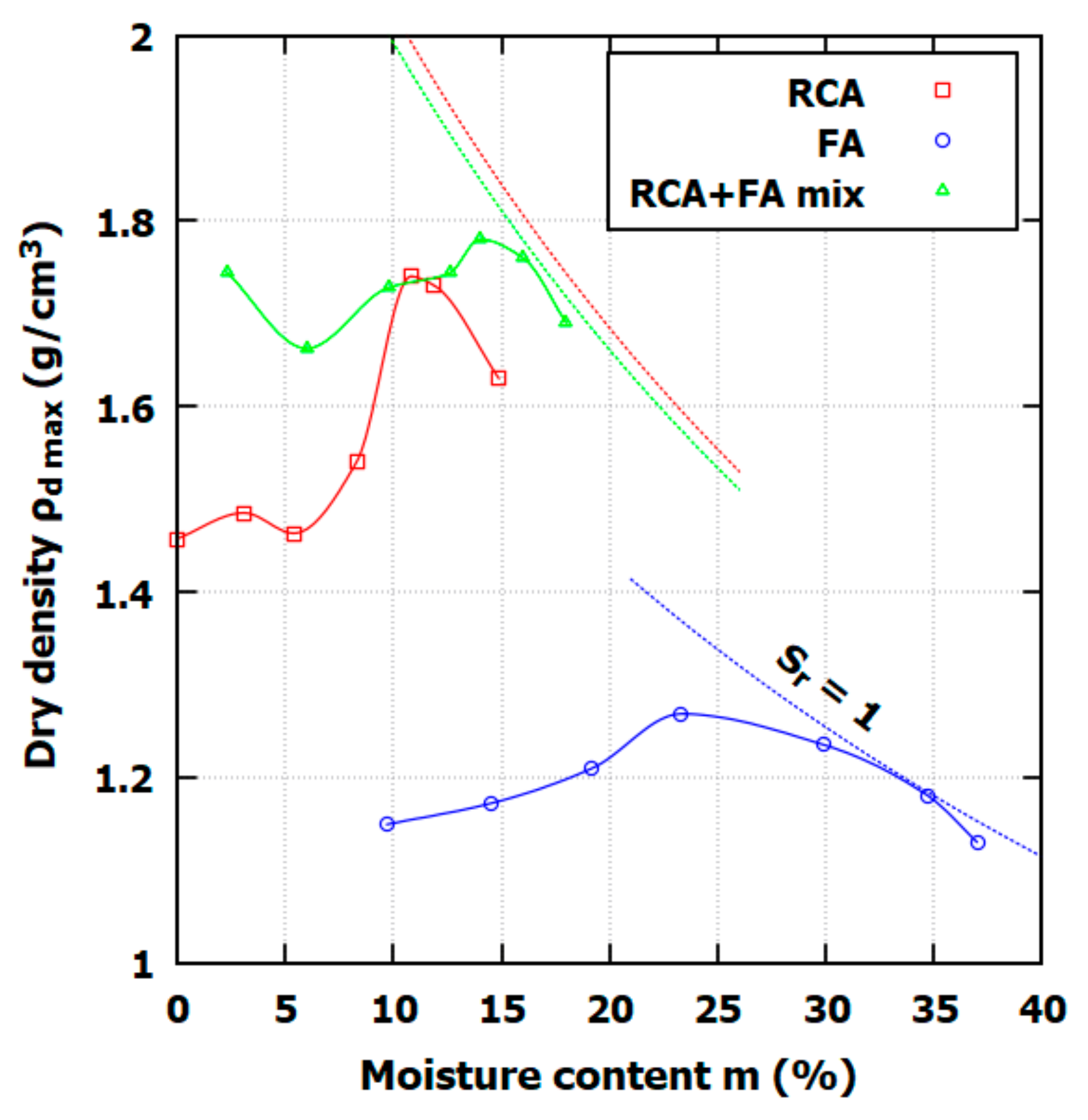

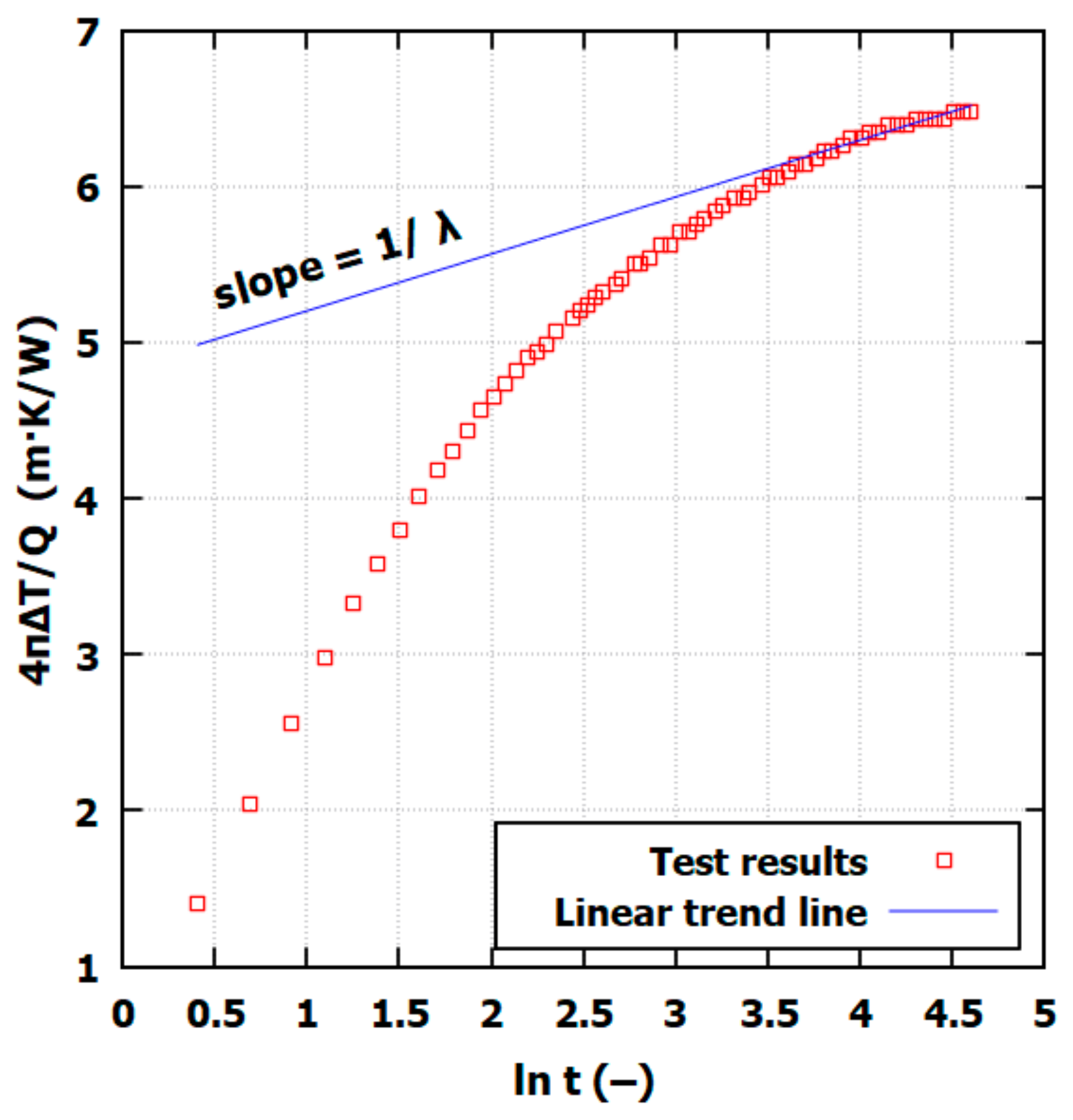

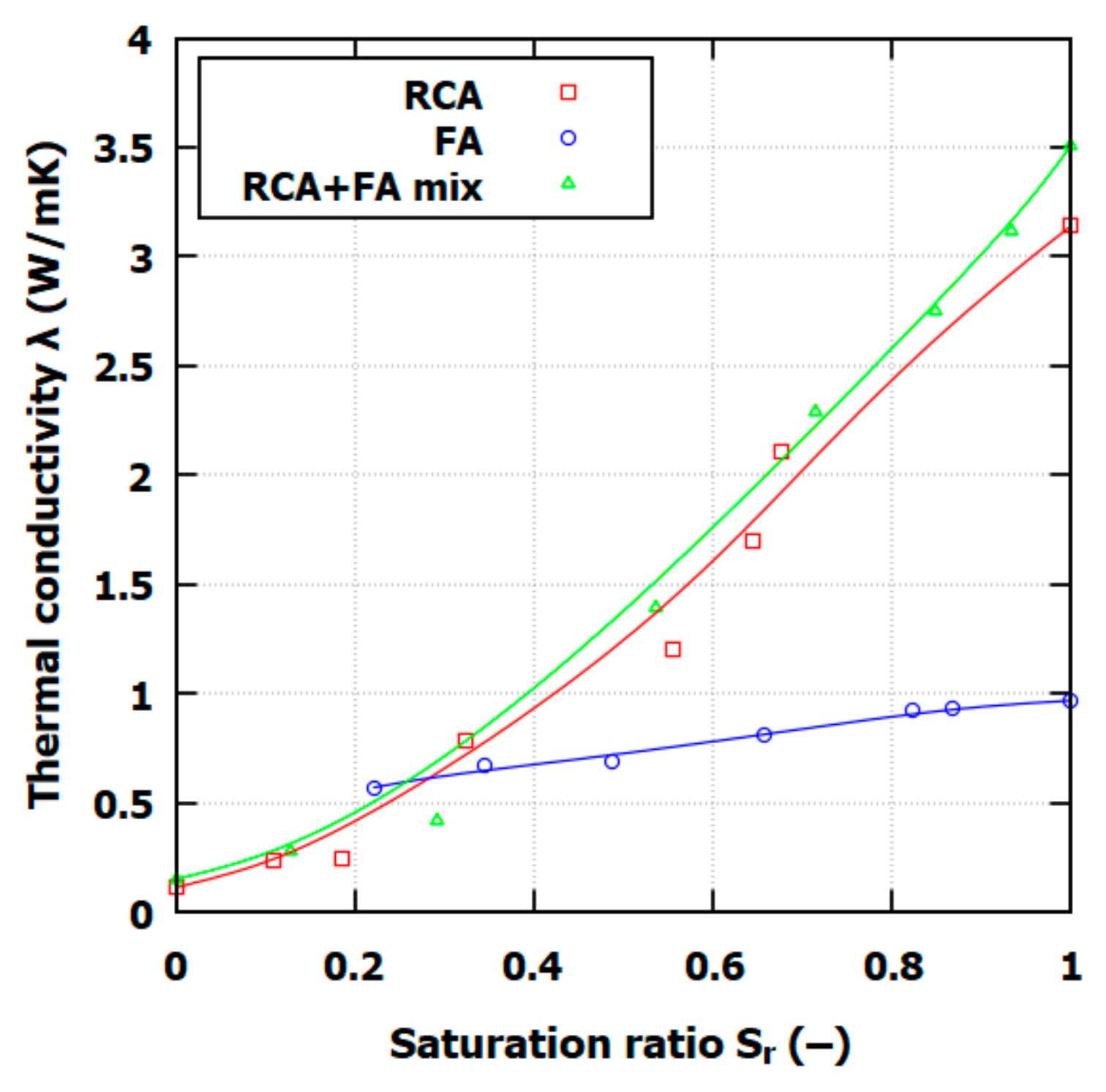
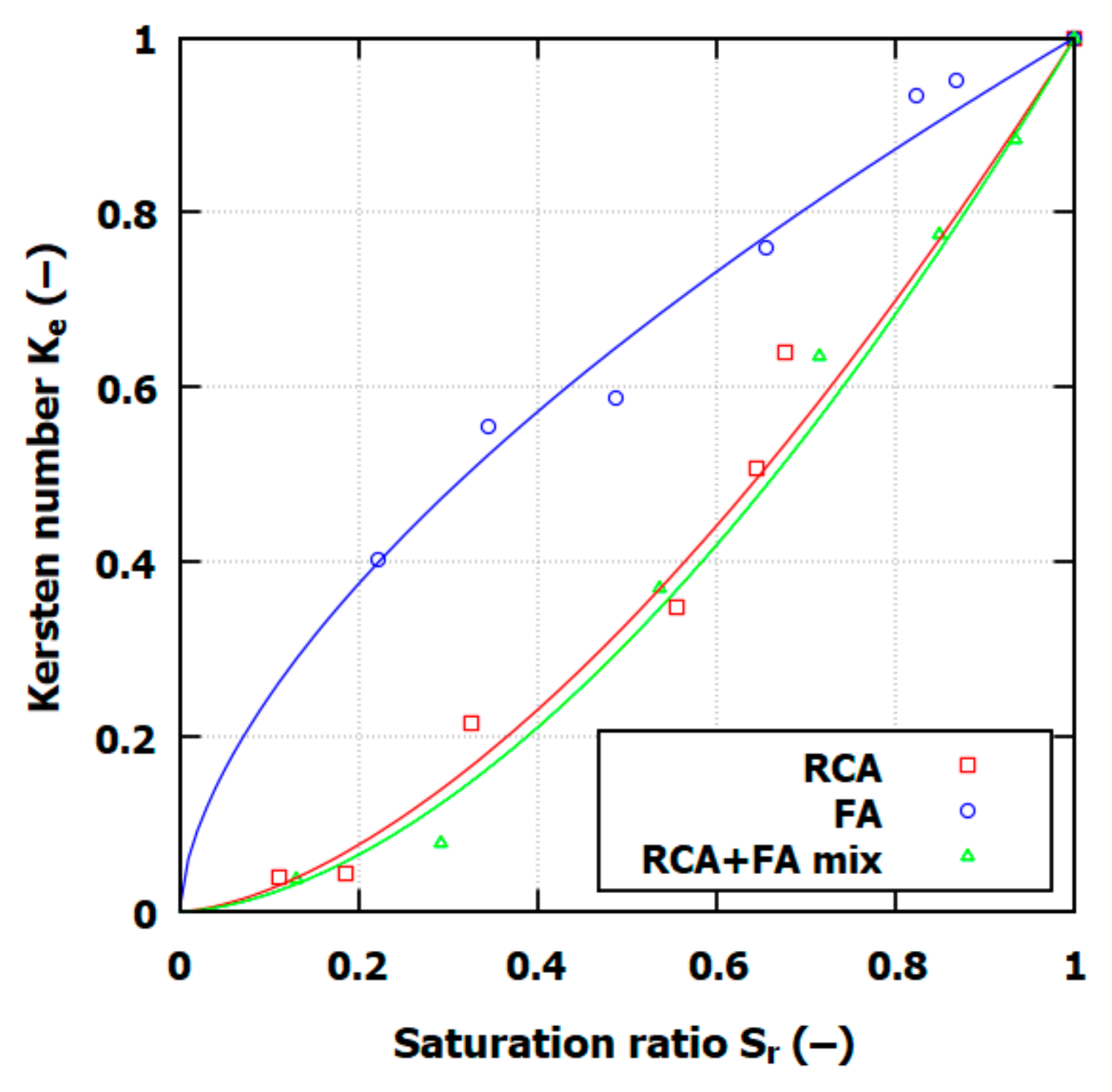
| Property | FA | RCA | RCA+FA |
|---|---|---|---|
| CU | 4.2 | 15.5 | 3.56 |
| CC | 0.61 | 6.13 | 1.73 |
| emax | 1.008 | 0.976 | 0.907 |
| emin | 0.178 | 0.552 | 0.204 |
| GS | 2.31 | 2.54 | 2.52 |
| FC | 0.92 | 0.46 | 0.83 |
| Property | FA | RCA | RCA+FA |
|---|---|---|---|
| OMC | 23.3 | 10.8 | 13.9 |
| ρd max | 1.268 | 1.738 | 1.781 |
| m (%) | ρd (g/cm3) | n (−) | Sr (−) | λ (W/mK) |
|---|---|---|---|---|
| RCA | ||||
| 0 | 1.46 | 0.425 | 0.00 | 0.110 |
| 3.1 | 1.49 | 0.413 | 0.11 | 0.233 |
| 5.4 | 1.46 | 0.425 | 0.19 | 0.244 |
| 8.3 | 1.54 | 0.394 | 0.32 | 0.782 |
| 10.8 | 1.74 | 0.315 | 0.56 | 1.2 |
| 11.9 | 1.73 | 0.319 | 0.65 | 1.7 |
| 14.9 | 1.63 | 0.358 | 0.68 | 2.11 |
| 17.4 | 1.6 | 0.370 | 1.00 | 3.24 |
| FA | ||||
| 9.7 | 1.15 | 0.428 | 0.22 | 0.569 |
| 14.5 | 1.17 | 0.417 | 0.35 | 0.671 |
| 19.2 | 1.21 | 0.398 | 0.49 | 0.692 |
| 23.3 | 1.27 | 0.369 | 0.66 | 0.807 |
| 29.9 | 1.25 | 0.376 | 0.82 | 0.923 |
| 34.7 | 1.20 | 0.403 | 0.87 | 0.934 |
| 37.0 | 1.13 | 0.438 | 1.00 | 0.967 |
| RCA+FA mix | ||||
| 0.0 | 1.64 | 0.349 | 0.00 | 0.15 |
| 2.3 | 1.71 | 0.321 | 0.13 | 0.278 |
| 6.0 | 1.66 | 0.340 | 0.29 | 0.415 |
| 9.8 | 1.73 | 0.314 | 0.54 | 1.396 |
| 12.6 | 1.74 | 0.308 | 0.71 | 2.286 |
| 14.5 | 1.78 | 0.294 | 0.85 | 2.75 |
| 16.1 | 1.76 | 0.302 | 0.93 | 3.12 |
| 18.7 | 1.69 | 0.329 | 1.00 | 3.51 |
| Soil | n | ||||
|---|---|---|---|---|---|
| RCA | 0.85 | 2.0 | 0.319 | 2.96 | 3.24 |
| FA | 0.0 | 1.1 | 0.403 | 0.86 | 0.93 |
| RCA+FA mix | 0.765 | 2.0 | 0.253 | 3.17 | 3.51 |
| RCA | FA | RCA+FA mix | |||
|---|---|---|---|---|---|
| Sr | Ke | Sr | Ke | Sr | Ke |
| 0.111 | 0.039 | 0.222 | 0.403 | 0.130 | 0.038 |
| 0.186 | 0.043 | 0.346 | 0.556 | 0.292 | 0.079 |
| 0.325 | 0.215 | 0.487 | 0.588 | 0.536 | 0.371 |
| 0.556 | 0.348 | 0.656 | 0.760 | 0.714 | 0.636 |
| 0.645 | 0.508 | 0.822 | 0.934 | 0.849 | 0.774 |
| 0.677 | 0.639 | 0.867 | 0.951 | 0.934 | 0.884 |
| 1.000 | 1.000 | 1.000 | 1.000 | 1.000 | 1.000 |
Disclaimer/Publisher’s Note: The statements, opinions and data contained in all publications are solely those of the individual author(s) and contributor(s) and not of MDPI and/or the editor(s). MDPI and/or the editor(s) disclaim responsibility for any injury to people or property resulting from any ideas, methods, instructions or products referred to in the content. |
© 2024 by the author. Licensee MDPI, Basel, Switzerland. This article is an open access article distributed under the terms and conditions of the Creative Commons Attribution (CC BY) license (https://creativecommons.org/licenses/by/4.0/).
Share and Cite
Głuchowski, A. Optimizing Backfill Materials for Ground Heat Exchangers: A Study on Recycled Concrete Aggregate and Fly Ash for Enhanced Thermal Conductivity. Materials 2024, 17, 5876. https://doi.org/10.3390/ma17235876
Głuchowski A. Optimizing Backfill Materials for Ground Heat Exchangers: A Study on Recycled Concrete Aggregate and Fly Ash for Enhanced Thermal Conductivity. Materials. 2024; 17(23):5876. https://doi.org/10.3390/ma17235876
Chicago/Turabian StyleGłuchowski, Andrzej. 2024. "Optimizing Backfill Materials for Ground Heat Exchangers: A Study on Recycled Concrete Aggregate and Fly Ash for Enhanced Thermal Conductivity" Materials 17, no. 23: 5876. https://doi.org/10.3390/ma17235876
APA StyleGłuchowski, A. (2024). Optimizing Backfill Materials for Ground Heat Exchangers: A Study on Recycled Concrete Aggregate and Fly Ash for Enhanced Thermal Conductivity. Materials, 17(23), 5876. https://doi.org/10.3390/ma17235876






